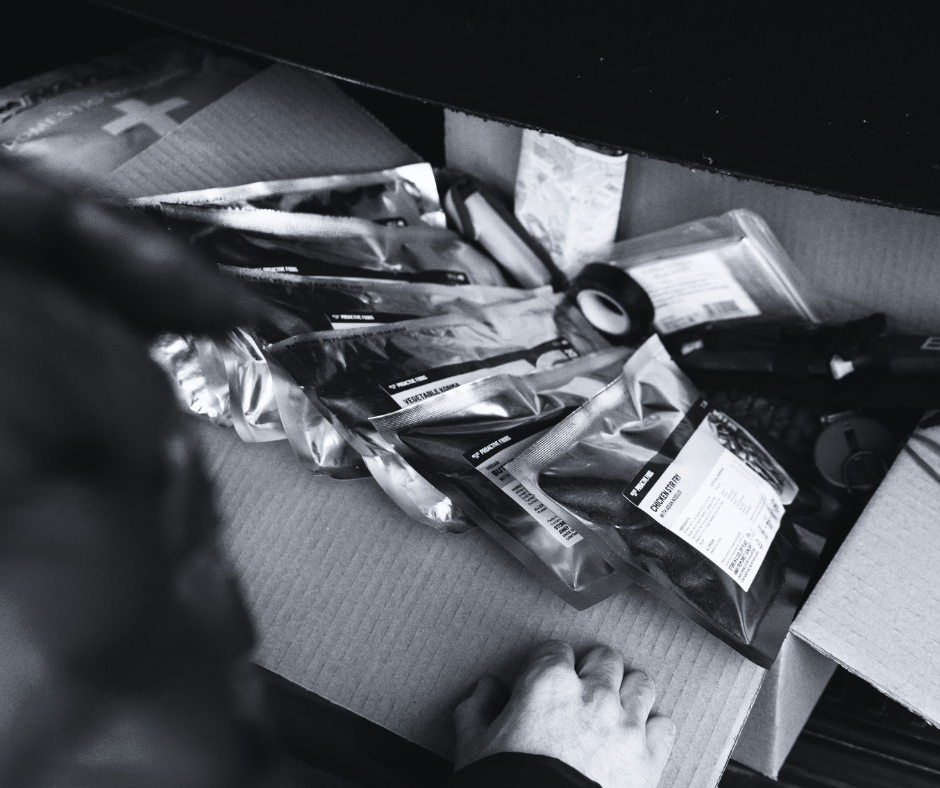
The Ultimate Checklist: The Essentials
When disaster strikes, having a well-prepared emergency kit can make all the difference. Whether you're facing a natural disaster, power outage, or any other unforeseen emergency, a comprehensive emergency kit ensures that you and your loved ones have the essentials to navigate the situation safely and comfortably.
Why Build an Emergency Kit?
An emergency kit is not just a collection of random supplies; it’s a lifeline during unexpected events. Preparing in advance means you can respond quickly and effectively, reducing stress and increasing your chances of staying safe. Here’s a guide to building a robust emergency kit that will help you survive a variety of scenarios.
1. Food and Water
Food
Your kit should include non-perishable food items that can sustain you over several days. Freeze-dried meals, canned goods, energy bars, and nuts are excellent choices. Proactive Foods offers a range of meals and single ingredients tailored to meet your nutritional needs. Our ready-to-go Emergency Food Kits, available in various sizes from 30 meals to 1080 meals, provide a convenient solution for long-term food security.
Water
A crucial element of any emergency kit is water. Ensure you have at least one gallon of water per person per day for three days. Additionally, include water purification tablets or a portable water filter to ensure access to safe drinking water in case your initial supply runs out.
Benefits of Freeze-Dried Food
Freeze-dried food is ideal for emergency preparedness, outdoor adventures, and long-term storage. It offers several advantages, such as an incredibly long shelf life, often extending beyond 25 years without refrigeration. This reliability reduces waste and the need for frequent replacements. Moreover, freeze-dried food retains most of its original nutrients, flavor, and texture, making it both healthy and enjoyable. Its lightweight nature also makes it easy to transport, whether you’re storing it at home or packing it for an outdoor adventure. Preparation is straightforward—just add water, and your meal is ready to eat.
Limitations of Freeze-Dried Food
-
Cost: Freeze-dried food may have a higher upfront cost compared to other preservation methods. However, the extended shelf life and superior nutrient retention make it a worthwhile investment, especially for emergency situations or outdoor activities.
-
Water Dependency: Rehydrating freeze-dried food requires access to safe drinking water. This challenge can be mitigated by including water purification tools, such as portable filters or purification tablets, in your kit. Additionally, all Proactive Foods’ meals are pre-cooked and safe to eat dry, providing a critical advantage in situations where water is scarce.
2. Shelter and Warmth
In an emergency, staying warm and protected from the elements is vital. Your kit should include:
- An emergency blanket (thermal or space blanket)
- Sleeping bags suitable for the climate
- A tent or tarp for temporary shelter
- Extra clothing, including warm layers, socks, and hats
- Waterproof clothing or a rain poncho
3. First Aid Kit
A well-stocked first aid kit can address minor injuries and prevent them from becoming more serious. Include:
- Bandages and gauze (various sizes)
- Antiseptic wipes and ointment
- Adhesive tape
- Tweezers and scissors
- Pain relievers (e.g., ibuprofen, acetaminophen)
- Prescription medications (a 7-day supply)
- Instant cold pack
- Medical gloves (non-latex)
- CPR face shield/face mask
4. Tools and Supplies
Having the right tools on hand can help you navigate and manage challenging situations. Essential items include:
- A multi-tool (with knife, pliers, screwdriver, etc.)
- A flashlight with extra batteries
- Matches or a lighter stored in a waterproof container
- A whistle for signaling help
- Duct tape for repairs and sealing
- Plastic sheeting and duct tape for shelter or sealing windows
- Ziplock bags to keep items dry
- Work gloves for protection
5. Personal Hygiene
Maintaining hygiene during an emergency can prevent illness and ensure comfort. Your kit should contain:
- Hand sanitizer or disinfecting wipes
- Toilet paper
- Toothbrush and toothpaste
- Soap or body wipes
- Feminine hygiene products
- Garbage bags for sanitation
6. Communication and Navigation
Staying informed and connected is crucial in an emergency. Include:
- A battery-powered or hand-crank radio
- A cell phone with chargers and a backup power bank
- An emergency contact list
- A map of the area with marked evacuation routes
- A compass
7. Important Documents
Ensure you have copies of critical documents, such as:
- Identification (driver’s license, passport)
- Insurance policies
- Emergency contacts and medical information
- Cash (small bills and coins)
- Copies of house and car keys
8. Additional Supplies for Special Needs
If you have specific needs, include supplies such as:
- Baby supplies (diapers, formula, baby food)
- Pet supplies (food, water, leash, carrier)
- Special medications or medical equipment
- Comfort items (toys, books, games)
9. Backup Power
In the event of a power outage, ensure you have:
- A solar charger or portable power bank
- Extra batteries for essential electronics
10. Miscellaneous Items
Other helpful items include:
- An emergency plan, including meeting points and evacuation routes
- A fire extinguisher
- A signal mirror or flare
- Local maps with key locations marked
Regular Maintenance of Your Emergency Kit
Building your emergency kit is just the first step. It’s crucial to regularly check and update the contents to ensure everything is in good condition and nothing has expired. Tailor your kit to your personal needs, local hazards, and specific scenarios you might face.
By taking the time to prepare an emergency kit now, you’re not just safeguarding yourself and your loved ones—you’re also gaining peace of mind knowing you’re ready to handle whatever comes your way.

Kommentaar
Los kommentaar